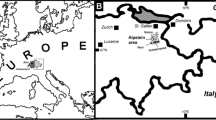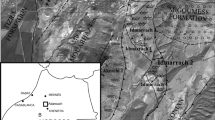Abstract
Limestone pebbles of the post-lower Bashkirian Marbella Formation (Malaguides, Internal Zone of the Betic Cordillera) yielded sixteen species of rugose corals belonging to eleven genera and two species of heterocorals belonging to two genera. The fauna is of uppermost Viséan age (V3b-V3c). Its paleogeographic significance within the western Mediterranean is discussed.
Lonsdaleia corbariensis, known up to now only from debris flow deposits of the Mouthoumet massif (Southern France), covers approximately half of the total fauna.Hexaphyllia mirabilis is shown to have juvenile stages with five septa.
Kurzfassung
Aus Kalkgeröllen der post-unterbashkirischen Marbella-Formation (Malagiden, Internzone der Betischen Kordillere) werden sechzehn Arten rugoser Korallen aus elf Gattungen und zwei Arten von Heterokorallen aus zwei Gattungen beschrieben. Die Fauna gehört dem Obervisé V3b-V3c an. Ihre paläogeographische Bedeutung im Rahmen des westlichen Mittelmeergebiets wird diskutiert.
Die bisher nur aus einem Debrisflow-Horizont des Massivs von Mouthoumet (Südfrankreich) bekannteLonsdaleia corbariensis stellt etwa die Hälite der Gesamtfauna. BeiHexaphyllia mirabilis lassen sich fünf-septale Jugendstadien nachweisen.
Similar content being viewed by others
Literatur
Altevogt, G. (1966):Lithostrotium scotiatm (Rugosa) aus dem Visé von Zafra/Spanien. — N. Jb. Geol. Paläont. Mh.,1966 (8): 494–500, 5 Abb.; Stuttgart.
Azema, J. (1961): Etude géologique des abords de Málaga (Espagne). — Estud. geol.,17: 131–160, 29 Abb., 1 geol. Kt.; Madrid.
Blumenthal, M. (1930): Beiträge zur Geologie der betischen Cordilleren beiderseits des Rīo Guadalhorce. — Ecl. geol. Helvet.,23: 41–293, 24 Abb., Taf. 7-9; Basel.
Boll, F.-C. (1983): Der Wandel der rugosen Korallenfaunen der Flachwasser-Fazies im Karbon des Kantabrischen Gebirges (Nordspanien). —Diss. Univ. Tübingen: 275 S., 73 Abb.; Tübingen.
Buchroithner, M.;FlÜgel, E.;FlÜgel, H. W. &Stattegger, K. (1980): Mikrofazies, Fossilien und Herkunft der Kalk-Gerölle im Karbon-»Flysch« der Betischen Kordilleren, Spanien. — Facies,2: 1–54, 2 Abb., 1 Tab., Taf. 1-8; Erlangen.
Crousilles, M.;Dixsaut, C.;Lys, M. &Tamain, G. (1976): Sur les calcaires du Carbonifère inférieur du Nord de Cordoue (Espagne) et leur âge viséen supérieur d’après la microfaune. — Ann. Soc. géol. Nord,96 (4): 399–406, 3 Abb., 1 Tab., 1 Taf.; Villeneuve d’Ascq.
Degtjarev, T. T. (1965): Novye rugozy iz nizhnego karbona Yuzhnogo Urala. — Paleont. Zhurn.,1: 48–53, Taf. 3-4; Moskau.
Dobrolyubova, T. A. (1958): Nizhnekamennougolnye kolonialnye chetyrechluchevye korally Russkoi platformy. — Trudy Paleont. Inst. Akad. Nauk SSSR,70: 1–224, 35 Abb., 38 Taf.; Moskau.
Chanton-Güvenc, N.;Huvelin, P. &Semenoff-Tian-Chansky, P. (1971): Les deux séries d’âge viséen supérieur du jbel Hadid prés de Khénifra (Maroc hercynien central). — Notes Serv. géol. Maroc,31 (no. 237): 7–10, 1 Abb.; Rabat.
Duncan, P. M. (1867): On the generaHeterophyllia, Battersbyia, Palaeocyclus andAsterosmilia; the anatomy of their species and their position in the classification of the sclerodermic zoantharia. — Phil. Trans. Roy. Soc. London,157: 643–656, Taf. 31-32; London.
Egeler, C. G. &Simon, O. J. (1969): Sur la tectonique de la Zone Bétique (Cordillères Bétiques, Espagne). — Verh. Kon. Ned. Akad. Wetensch., Afd. Nat., 1. reeks,25 (3): 90 S., 16 Abb., 3 Taf.; Amsterdam.
Engel, W. (1984): Migration of folding and flysch sedimentation on the southern flank of the Variscan belt (Montagne Noire, Mouthoumet Massif, Pyrenees). — Z. dt. geol. Ges.,135(1): 279–292, 3 Abb.; Hannover.
Engel, W. &Franke, W. (1983): Flysch-sedimentation: its relations to tectonism in the European Variscides. — [In:]Martin, H. &Eder, F. W. (eds.): Intracontinental Fold Belts: 289–321, 5 Abb.; Berlin- Heidelberg (Springer).
Fedorowski, J. (1971): Aulophyllidae (Tetracoralla) from the Upper Visean of Sudetes and Holy Cross Mountains. — Palaeontographica Polonica,24 (1970): 1–137, 52 Abb., 9 Tab., 23 Taf.; Warschau.
Fedorowski, J. &Gorianov, V. B. (1973): Redescription of tetracorals described by E. Eichwald in »Palaeontology of Russia«. — Acta Palaeont. Polonica,18 (1): 3–70, 20 Abb., 13 Taf.; Warschau.
Garwood, E.J. (1913): The lower Carboniferous succession in the northwest of England. — Quart. J. geol. Soc. London,68: 449–586, 12 Abb., Taf. 44-56; London.
Geel, T. (1973): The geology of the Betic of Málaga, the Subbetic and the zone between these two units in the Vélez Rubio area (Southern Spain). — GUA papers of Geol., Ser. 1,5: 178 S., 40 Abb., 4 Beil., Anhang I–II; Amsterdam.
Gorsky, I. I. (1935): Nekotorye Coelenterata iz nizhnekamennougolynch otlozhenij Novoi Zemli. — Trudy Vses. arkt., in-ta,28: 128 S., 27 Abb., 12 Taf.; Leningrad.
—— (1938): Kamennougolyne korally Novoi Zemli. Paleontologija Sovetskoi Arktiki II. — Trudy Vses. arkt. in-ta,93 (2): 1–221, 81 Abb., 16 Taf.; Leningrad.
Herbig, H.-G. (1983): El Carbonífero de las Cordilleras Béticas. —[In]:Martinez-Diaz, C. (ed.): Carbonífero y Permico de España (10. Congr. int. Estrat. Geol. Carbonífero, Madrid 1983): 345–356, 379–380, Abb. X.l —X.3; Madrid.
—— (1984): Rekonstruktion eines nicht mehr existenten Sedimentationsraumes —Die Kalkgerölle im Karbon-Flysch der Malagiden (Betische Kordillere, Südspanien). — Facies,11: 1–108, 21 Abb., 2 Tab., Taf. 1-8; Erlangen.
Herbig, H.-G. &Mamet, B. (1985): Stratigraphy of the limestone boulders, Marbella Formation (Betic Cordillera, Southern Spain). — C. R. l0è Congr. int. Strat. Gèol. Carbonifère, Madrid 1983, Vol.1: 199–212, 2 Abb., 3 Taf; Madrid.
Hill, D. (1938-1941): A monograph on the Carboniferous rugose corals of Scotland. — Palaeontogr. Soc. London,91 (1938): 1–78, Abb. A-B, Tab. 1-8, Taf. 1-2;92 (1939): 79-114, Taf. 3-5;94 (1940): 115-204, Abb. C, Taf. 6-11;95 (1941): 205-213; London.
Hill, D. (1956): Rugosa. —[In:] Moore, R. C. (ed.): Treatise on Invertebrate Paleontology, part F, Coelenterata: F233–F324, Abb. 165–219; Lawrence/Kansas.
Hill, D. (1981): Coelenterata: Anthozoa. Subclasses Rugosa, Tabulata. —[In:]Teichert, C. (ed.): Treatise on Invertebrate Paleontology, part F, Coelenterata, Suppl. 1, Rugosa and Tabulata: 762 S., 462 Abb., 3 Tab.; Boulder/Colorado-Lawrence/Kansas.
Kabakovitsh, N. V. (1952): Korally roda Palaeosmilia iz nizhnego karbona Podmoskovnogo bassejna. — Trudy Paleont. Inst. Akad. Nauk SSR,40: 85–114, 7 Taf.; Moskau.
Khoa, N. D. (1977): Carboniferous Rugosa and Heterocorallia from boreholes in the Lublin region (Poland). — Acta Palaeont. Polonica,22 (4): 301–404, 45 Abb., 6 Tab., 27 Taf.; Warschau.
Kostic-Podgorska, V. (1957): La fauna des coraux de calcaires crinoides dans les environs de Praca (Bosnie). —Trav. Inst. Geol. »Jovan Zujović«, No. 9:49–91,3 Tab., 15 Taf.; Belgrad. [russ. mit franz. Zsf.]
Lafuste, J. (1981): Microstructure des Hétérocoralliaires (Cnidaria; Carbonifère). — Ann. Paléont. (Invertébrés),67 (1): 1–12, 4 Abb., 2 Taf.; Paris.
Lewis, H. P. (1924): Upper Viséan corals of the genusCaninia. — Quart. J. Geol. Soc. London,80:389–407, Taf. 27-30; London.
—— (1931): The Upper Viséan coralCaninia concavea (Thomson). — Ann. Mag. nat. Hist., ser. 10,16: 118–142, Taf. 5-7; London.
Mamet, B. (1974): Une zonation par Foraminifères du Carbonifère inférieur de la Téthys occidentale. — C. R. 7è Congr. Int. Strat. Géol. Carbonifére, Krefeld 1971,3: 391–407, 4 Abb.; Krefeld.
Mamet, B. &Martinez, C. (1981): Late Viséan microfossils of the Las Caleras Bajas Limestone (Cordoba, Spain). — Rev. Española Micropaleont.,13 (1): 105–118, 1 Abb., 3 Taf.; Madrid.
McCoy, F. (1844): A synopsis of the characters of the Carboniferous Limestone fossils of Ireland: VIII + 207 S., 29 Taf.; Dublin.
—— (1849): On some new genera and species of Palaeozoic corals and foraminifera. — Ann. Mag. nat. Hist., ser. 2,3: 1–20, 3 Abb.; 119-136, 4 Abb.; London.
Menchikoff, N. &Hsu, T.-Y. (1935): Les polypiers Carbonifères du Sahara occidental. — Bull. Soc. géol. France, ser. 5,5: 229–261, Taf. 9-10; Paris.
Michelau, P. (1943): Das Paläozoikum der Betischen Ketten nordwestlich von Málaga. —Diss. Univ. Berlin: 44 S., 6 Abb., 1 geol. Kt.; Berlin.
Milliard, Y. (1959): Sur la présence d’assises carbonifères dans le massif paléozoique interne du Rif. — C. R. Acad. Sci. Paris,249: 1688–1690; Paris.
Milne-Edwards, H. &Haime, J. (1848): Recherches sur les polypiers. Quadrième Mémoire. Monographie des Astréides. — Ann. Sci. nat., ser. 3,10: 209–319, Taf. 5-9; Paris.
Milne-Edwards, H. (1851): Monographie des polypiers fossiles des terrains palaeozoiques, précédée d’un tableau général de la classification des polypes. —Arch. Mus. Hist. nat. Paris,5: 502 S., 20 Taf.; Paris.
—— (1852): A monograph of the British fossil corals. Third part. Corals from the Permian Formation and the Mountain Limestone. — Palaeontogr. Soc,6: 147–210, Taf. 31-46; London.
Minato, M. (1955): Japanese Carboniferous and Permian corals. — J. Fac. Sci. Univ. Hokkaido, ser. 4,9 (2): 1–202, 25 Abb., 43 Taf.; Sapporo.
Minato, M. &Kato, M. (1965): Waagenophyllidae. -J. Fac. Sci. Univ. Hokkaido, ser. 4,12 (3-4): XIII + 241 S., 56 Abb., 20 Taf.; Sapporo.
Navarro, E. &Lacazette, F. (1922): Estudio de la cuenca Carbonífera de los Santos de Maimona (Badajoz). — Bol. oficial Minas y Metalurgia,6 (No. 63): 17–31, 1 Abb.; Madrid.
Niikawa, I. (1979):Carcinophyllum from the Ichinotani Formation in Fukuji, Central Japan. — J. Fac. Sci. Univ. Hokkaido, ser. 4,19 (1-2): 235–240, 1 Abb., 1 Taf.; Sapporo.
Niikawa, I. Rugose corals from Fukuji, Central Japan. Part I. Carboniferous. — J. Gen. Educ. Dep., Niigata Univ., No. 11: 131-161, 1 Abb., 7 Taf.; Niigata.
Perret, M. F. &Semenoff-Tian-Chansky, P. (1971): Coralliaires des calcaires carbonifères d’Ardengost (Hautes-Pyrénées). — Bull. Soc. Hist. nat. Toulouse,107 (3-4): 567–594, 5 Taf.; Toulouse.
Phillips, J. (1836): Illustrations of the geology of Yorkshire, part 2: The Mountain Limestone district: XX + 253 S., 25 Taf.; London.
Poty, E. (1978): Donées nouvelles sur les Hétérocoralliaires du Dinantien Belge. — Ann. Soc. géol. Belg.,100 (1977): 233–243, 5 Abb., 2 Taf.; Brüssel.
—— (1981): Recherches sur les Tütracoralliaires et les Hütürocoralliaires du Visüen de la Belgique. — Me- ded. Rijks geol. Dienst,35 (1): 1–161, 63 Abb., 9 Tab., 34 Taf.; Roermond.
Rodriguez, S. (1984): Carboniferous corals from Eastern Cantabrian Mountains: paleogeographic implications. — Palaeontographica Americana,54 (Eds.: Oliver, W. A., Jr.; Sando, W. J.; Cairns, S. T.; Coates, A. G.; Macintyre, I. G.; Bayer, F. M. & Sorauf, J. E.): 433–436,2 Abb.; Lawrence/Kansas.
Rozkowska, M. (1969): Famennian tetracoralloid and heterocoralloid fauna from the Holy Cross Mountains (Poland). — Acta Palaeont. Polonica,14 (1): 1–187, 72 Abb., Taf. 1-8; Warschau.
Ryder, T. A. (1930): Notes on »Carcinophyllum, Nich. & Thom.«, with descriptions of two new species. — Ann. Mag. nat. Hist., ser. 10,5: 337–351, 5 Abb.; London.
Salée, A. (1913): Contribution à ľétude des polypiers du Calcaire Carbonifère de la Belgique. II. Le groupe des Clisiophyllides. — Mém. Inst. géol. Univ. Louvain,1: 179–293, 5 Abb., Taf. 4-11; Louvain.
Schindewolf, O. H. (1941): Zur Kenntnis der Heterophylliden, einer eigentümlichen paläozoischen Korallengruppe. — Paläont. Z.,22: 213–306, 54 Abb., Taf. 9-16; Berlin.
Semenoff-Tian-Chansky, P. (1974): Recherches sur les tétracoralliaires du Carbonifère du Sahara occidental. —Centre rech. zones arides, ser. géol, No. 21: 316 S., 100 Abb., 4 Tab., 76 Taf.; Paris (ed.: CNRS).
Semenoff-Tian-Chansky, P. &Ovtracht, A. (1966): Madréporaires du Carbonifère des Hautes-Cor-bieres. — Bull. Soc. géol. France, ser. 7,7 (1965): 722–732, 3 Abb., Taf. 29-30; Paris.
Thomson, J. (1883): On the development and generic relatíon of the corals of the Carboniferous System of Scotland. — Proc. Roy. philos. Soc. Glasgow,14: 296–502, Taf. 1-14; Glasgow.
Thomson, J. (1893): On the generaCalophyllum andCampophyllum. — Proc. Roy. Irish Acad., ser. 3,2: 667–758, Taf. 15-21; Dublin.
Thomson, J. &Nicholson, H. A. (1875-1876): Contributions to the study of the chief generic types of the Palaeozoic corals. — Ann. Mag. nat. Hist., ser. 4,16 (11): 305–309; 16 (12): 424-429, Taf. 12; 17 (1): 60-70, Taf. 6-7; 17 (2): 123-128, Taf. 8;17 (4): 290-305, Taf. 12-17; 17 (6): 451-461, Taf. 21-25; 18 (7): 68-73, Taf. 1-3; London.
Unsalaner-Kiragli, C. (1958): Lower Carboniferous corals from Turkey. — J. Paleont. Soc. India,3: 53–58, 1 Abb., 1 Tab., Taf. 11-12; Lucknow.
Author information
Authors and Affiliations
Rights and permissions
About this article
Cite this article
Herbig, HG. Rugosa und Heterocorallia aus Obervisé-Geröllen der Marbella-Formation (Betische Kordillere, Südspanien). Paläontol. Z. 60, 189–225 (1986). https://doi.org/10.1007/BF02985668
Issue Date:
DOI: https://doi.org/10.1007/BF02985668




